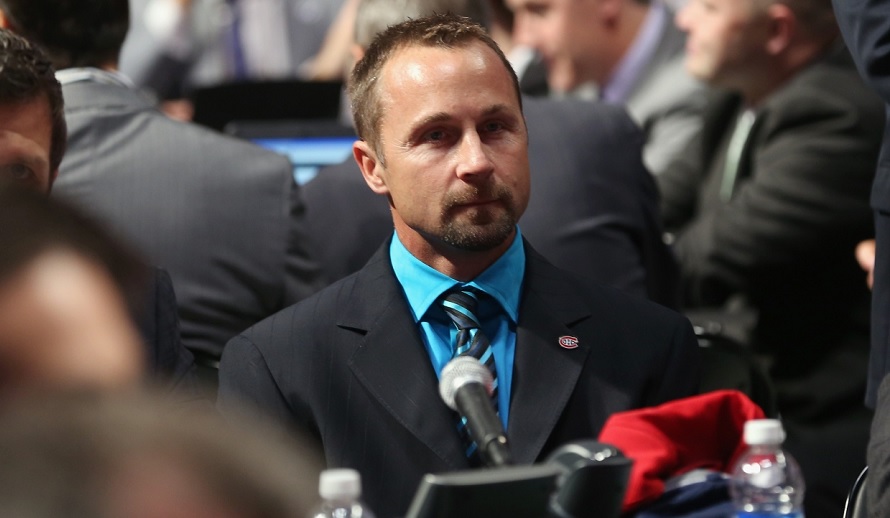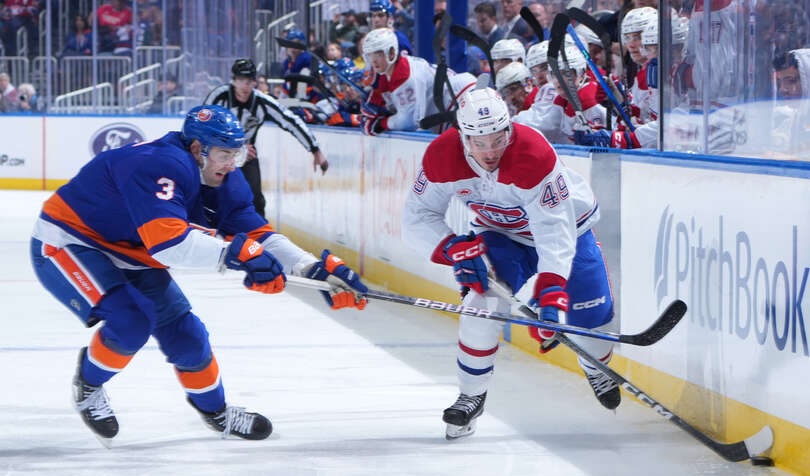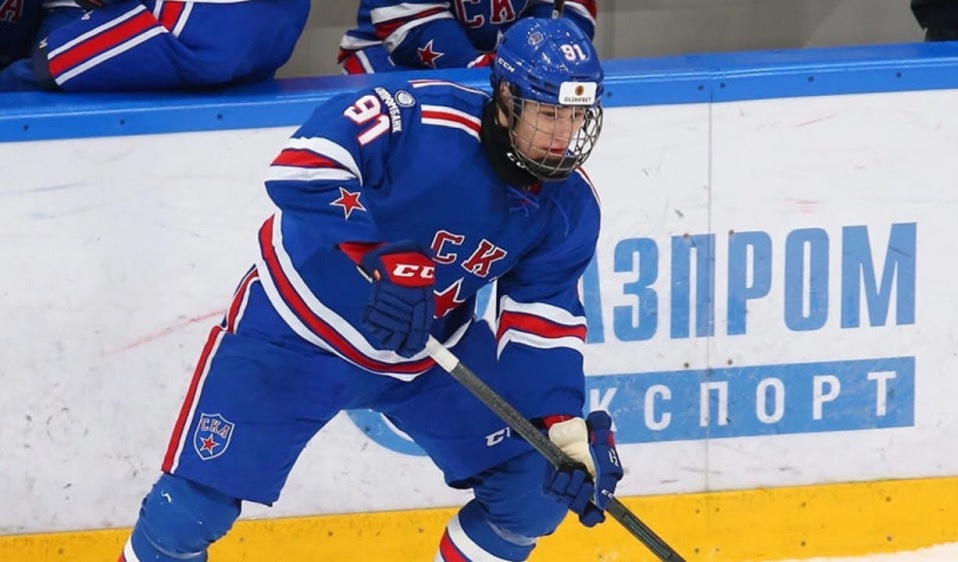HabsWorld.net --
Article written by Pierre Ferland.
Even good poker players can’t win all the time, they have to go with the cards they draw. The best they may expect is to beat the odds and play better than their hands. The same applies to the NHL draft, you can’t expect every prospect picked to make the big show but you may try to get a better return than the value of your picks.
Montreal fans are continually asking the same question: is Trevor Timmins really the best at drafting? They are looking at prospects, pointing at the ones that got away, arguing that development could have been better, combing each draft but the debate is still going on. I am not proposing to close it once and for all, but rather to look at it from another point of view by asking the question: Has Timmins beaten the odds?
First you have to establish what the odds are. Many people have tried to put value on draft choices and on NHL draft choices, publishing probabilities of success, equations and charts. In order not to repeat all the process, I have arbitrarily selected the 2011 Michael Shuckers NHL draft value pick chart to establish the odds. Since the period of scope will go from 2003 to 2013, running from Timmins’ first draft (we have to suppose he is the one calling the shots) to the last one players drafted by the Habs played in the NHL, the 2011 chart seems to be the best choice.
Now suppose every team got their draft choices determined by their standing and the lottery and only theirs, they would have the following Shuckers’s points (SP) for a seven round draft:
| Order | SP | Order | SP | Order | SP |
| 1 | 1709 | 11 | 1240 | 21 | 976 |
| 2 | 1651 | 12 | 1204 | 22 | 959 |
| 3 | 1593 | 13 | 1170 | 23 | 945 |
| 4 | 1537 | 14 | 1137 | 24 | 932 |
| 5 | 1486 | 15 | 1106 | 25 | 921 |
| 6 | 1438 | 16 | 1080 | 26 | 909 |
| 7 | 1393 | 17 | 1055 | 27 | 899 |
| 8 | 1352 | 18 | 1033 | 28 | 884 |
| 9 | 1313 | 19 | 1013 | 29 | 872 |
| 10 | 1277 | 20 | 996 | 30 | 857 |
But everybody knows that draft pick is a currency used to buy and sell players and coaches, created like bitcoins to compensate teams for unsigned draft picks, (and there were nine rounds in 2003 and 2004) so teams came to the draft table with various number of draft picks and various total of Shuckers’s points. So from 2003 to 2013, the number of draft choices (Picks) were as follows:
| Team | Rank | Picks | Team | Rank | Picks | Team | Rank | Picks |
| Chicago | 1 | 107 | Winnipeg | 11 | 86 | Dallas | 21 | 80 |
| Nashville | 2 | 94 | Tampa Bay | 12 | 84 | Detroit | 22 | 80 |
| NY Islanders | 3 | 92 | Ottawa | 13 | 83 | Calgary | 23 | 79 |
| Florida | 4 | 90 | San Jose | 14 | 82 | Arizona | 24 | 79 |
| Columbus | 5 | 90 | Montreal | 15 | 82 | Minnesota | 25 | 78 |
| Edmonton | 6 | 90 | Philadelphia | 16 | 81 | Carolina | 26 | 75 |
| Buffalo | 7 | 89 | Anaheim | 17 | 81 | New Jersey | 27 | 74 |
| Los Angeles | 8 | 89 | Colorado | 18 | 81 | Boston | 28 | 74 |
| St. Louis | 9 | 89 | Pittsburgh | 19 | 80 | Toronto | 29 | 74 |
| Washington | 10 | 86 | NY Rangers | 20 | 80 | Vancouver | 30 | 71 |
The average number of choices by team was 83.3. And the Shuckers’s average points (SP) by team and by draft were:
| Team | Rank | SP | Team | Rank | SP | Team | Rank | SP |
| Chicago | 1 | 1496.1 | Winnipeg | 11 | 1268.5 | Dallas | 21 | 1097.1 |
| Edmonton | 2 | 1475.0 | Arizona | 12 | 1241.9 | Ottawa | 22 | 1088.3 |
| Florida | 3 | 1467.3 | Nashville | 13 | 1223.5 | Philadelphia | 23 | 1040.3 |
| NY Islanders | 4 | 1455.1 | Pittsburgh | 14 | 1213.9 | Boston | 24 | 1039.2 |
| Columbus | 5 | 1421.6 | Tampa Bay | 15 | 1171.2 | Calgary | 25 | 1017.5 |
| St. Louis | 6 | 1328.8 | Carolina | 16 | 1170.5 | San Jose | 26 | 986.8 |
| Los Angeles | 7 | 1324.7 | Colorado | 17 | 1165.7 | Toronto | 27 | 935.7 |
| Washington | 8 | 1281.3 | Montreal | 18 | 1151.2 | New Jersey | 28 | 891.8 |
| Buffalo | 9 | 1278.1 | NY Rangers | 19 | 1139.3 | Vancouver | 29 | 872.6 |
| Anaheim | 10 | 1271.9 | Minnesota | 20 | 1122.4 | Detroit | 30 | 839.1 |
So Montreal is in the middle of the pack being 15th for the number of draft choices and 18th for the average total of SP by draft year. Those were the odds Trevor Timmins and the Montreal Canadiens dealt themselves at the draft table.
What did they do or rather what did Timmins do with those odds? Many statistics have been tried to express the outcome of the draft but the one that I saw most frequently was the number of games played in the NHL by drafted players whether it is with the drafting team or not. The number of games played was the metric used to build Shuckers’s table. Let’s take a look at the games played (GP) by players drafted by teams from 2003 to 2013:
| Team | Rank | GP | Team | Rank | GP | Team | Rank | GP |
| Chicago | 1 | 8606 | Boston | 11 | 7600 | Minnesota | 21 | 6026 |
| San Jose | 2 | 8424 | Washington | 12 | 7441 | Philadelphia | 22 | 5810 |
| Los Angeles | 3 | 8352 | Edmonton | 13 | 7307 | Arizona | 23 | 5790 |
| Columbus | 4 | 8220 | NY Islanders | 14 | 7178 | Toronto | 24 | 5583 |
| Buffalo | 5 | 8152 | Ottawa | 15 | 6991 | Detroit | 25 | 5482 |
| Montreal | 6 | 8141 | NY Rangers | 16 | 6500 | Winnipeg | 26 | 4867 |
| St. Louis | 7 | 8135 | Colorado | 17 | 6467 | Vancouver | 27 | 4640 |
| Anaheim | 8 | 8050 | Carolina | 18 | 6088 | New Jersey | 28 | 4531 |
| Nashville | 9 | 7852 | Florida | 19 | 6079 | Tampa Bay | 29 | 4425 |
| Pittsburgh | 10 | 7655 | Dallas | 20 | 6030 | Calgary | 30 | 4190 |
Coming from 15th for the number of draft choices and 18th for the number of SP all the way to 6th for GP by drafted players is quite a climb up, but let’s look at the number of games played by players drafted for each SP they had after draft day (GP/SP):
| Team | Rk | GP/SP | Team | Rk | GP/SP | Team | Rk | GP/SP |
| San Jose | 1 | 0.776 | St. Louis | 11 | 0.557 | Vancouver | 21 | 0.483 |
| Boston | 2 | 0.665 | Toronto | 12 | 0.542 | Carolina | 22 | 0.473 |
| Montreal | 3 | 0.643 | Washington | 13 | 0.528 | New Jersey | 23 | 0.462 |
| Detroit | 4 | 0.594 | Columbus | 14 | 0.526 | Edmonton | 24 | 0.450 |
| Ottawa | 5 | 0.584 | Chicago | 15 | 0.523 | NY Islanders | 25 | 0.448 |
| Nashville | 6 | 0.583 | NY Rangers | 16 | 0.519 | Arizona | 26 | 0.424 |
| Buffalo | 7 | 0.580 | Philadelphia | 17 | 0.508 | Florida | 27 | 0.377 |
| Anaheim | 8 | 0.575 | Colorado | 18 | 0.504 | Calgary | 28 | 0.374 |
| Pittsburgh | 9 | 0.573 | Dallas | 19 | 0.500 | Winnipeg | 29 | 0.349 |
| Los Angeles | 10 | 0.573 | Minnesota | 20 | 0.488 | Tampa Bay | 30 | 0.343 |
That last table really compares the odds, Shuckers’s points, with the outcome, games played by the draftees and shows that Timmins gets a bronze medal at beating the odds from 2003 to 2013 at the draft table. He might not be the best, but based on past performances, I sure would like him at the table if I were the GM.


